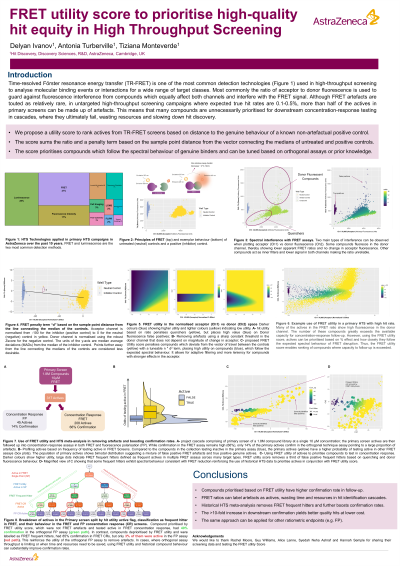Screening Applications & Diagnostics
Poster Session B
(1045-B) FRET utility score to prioritise high-quality hit equity in High Throughput Screening
Wednesday, May 29, 2024
10:30 - 11:15 CEST
Location: Exhibit Hall


Delyan Ivanov, PhD
Associate Director HTS
AstraZeneca
CAMBRIDGE, England, United Kingdom
Poster Presenter(s)
Abstract: Time-resolved Förster resonance energy transfer (TR-FRET) is one of the most common detection technologies used in high-throughput screening to analyze molecular binding events or interactions for a wide range of target classes. Most commonly the ratio of acceptor to donor fluorescence is used to guard against fluorescence interference from compounds which equally affect both channels and interfere with the FRET signal. Although FRET artefacts are touted as relatively rare, in untargeted high-throughput screening campaigns where expected true hit rates are 0.1-0.5%, more than half of the actives in primary screens can be made up of artefacts. This means that many compounds are unnecessarily prioritised for downstream concentration-response testing in cascades, where they ultimately fail, wasting resources and slowing down hit discovery.
To overcome this limitation, we propose a simple utility score to rank the actives from TR-FRET screens based on how close they are to the genuine behaviour of a known non-artefactual positive control. The utility score combines the ratio and a tuneable penalty term based on the sample point distance from the vector connecting the medians of an untreated and a full response control. The score prioritises compounds which follow the expected spectral behaviour of genuine binders and can be calibrated based on orthogonal assays or prior knowledge.
We have employed the FRET utility scoring to prioritise actives in multiple high-throughput screening campaigns in AstraZeneca across a wide variety of targets. Our experience has shown that the score is especially useful in cases where the donor signal is low and donor fluorescence is large. Compounds prioritised based on best utility score had a much higher chance in confirming in downstream assays and were taken up for further development. In contrast, compounds deprioritised based on the FRET utility score, showed activity in artefact assays, failed to confirm in orthogonal techniques and did not progress further. The same approach can be used to prioritise other ratiometric measurements like fluorescence polarization (FP). To this end we would like to share our experience with the screening community to foster the wider adoption of the technique.
To overcome this limitation, we propose a simple utility score to rank the actives from TR-FRET screens based on how close they are to the genuine behaviour of a known non-artefactual positive control. The utility score combines the ratio and a tuneable penalty term based on the sample point distance from the vector connecting the medians of an untreated and a full response control. The score prioritises compounds which follow the expected spectral behaviour of genuine binders and can be calibrated based on orthogonal assays or prior knowledge.
We have employed the FRET utility scoring to prioritise actives in multiple high-throughput screening campaigns in AstraZeneca across a wide variety of targets. Our experience has shown that the score is especially useful in cases where the donor signal is low and donor fluorescence is large. Compounds prioritised based on best utility score had a much higher chance in confirming in downstream assays and were taken up for further development. In contrast, compounds deprioritised based on the FRET utility score, showed activity in artefact assays, failed to confirm in orthogonal techniques and did not progress further. The same approach can be used to prioritise other ratiometric measurements like fluorescence polarization (FP). To this end we would like to share our experience with the screening community to foster the wider adoption of the technique.
